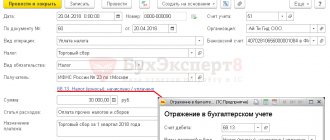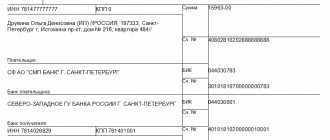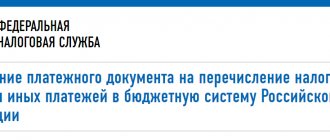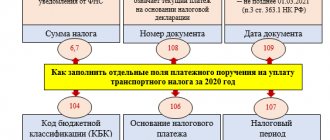Standard
The new rules are due to the adoption of several regulations.
- Federal Law No. 12-FZ of February 21, 2019 “On Amendments to the Federal Law “On Enforcement Proceedings”;
- Directive of the Central Bank No. 5286-U dated October 14, 2019 “On the procedure for indicating the type of income code in orders for the transfer of funds,” registered with the Ministry of Justice on January 14, 2020;
- Letter of the Central Bank No. 45-1-2-OE/8224 dated 06/08/2020.
Results
Payments to the FSSP are a transfer there of funds withheld by the employer from the employee’s salary under a writ of execution. Non-tax and tax debts can be paid in this way. In the second case, the payment document will be drawn up according to the rules applied for budget payments, but taking into account some of the features of entering data into certain fields.
If there is a writ of execution and it is necessary to withhold part of the employees’ wages by court decision, it is necessary to generate a payment order. This article will help you avoid mistakes when filling out a payment order to bailiffs.
Sep 10, 2019Dmitry Koloskov
Codes
Law 12-FZ establishes that persons paying a citizen a salary or other income, in respect of which Article 99 FZ-229 (on enforcement proceedings) establishes restrictions or for which, in accordance with Article 101 229-FZ, cannot be levied, are required to indicate in the payment documents the corresponding code for the type of income.
What is it for? The fact is that the bank needs this information in order to understand whether it is possible to write off funds from the amount received on the card according to the executive document or not.
Central Bank Directive No. 5286-U regulates the procedure for indicating the code in the payment order. The code of the type of income is indicated in detail 20 “Name. pl." payment order.
List of codes and cases of their use:
When transferring funds that are not income, for which restrictions are established by Articles 99, 101 of Federal Law No. 229-FZ, the type of income code is not indicated.
How to fill out a payment order to transfer taxes for an employee to bailiffs
Credit the amounts of tax debt withheld from the employee to the bailiffs, if specified in the resolution.
These amounts are intended to be credited to the budget. And in practice, information about the payer, recipient and payment in such a payment order is filled out taking into account Appendices No. 1, 4, 5 to Order of the Ministry of Finance of Russia dated November 12, 2013 No. 107n and Appendix 1 to the Regulations of the Bank of Russia dated June 19, 2012 No. 383-P.
In this case, do not fill in fields 19, 20, 23, 110 (Appendix 1 to Bank of Russia Regulations dated June 19, 2012 N 383-P).
If you have any difficulties when completing a payment order, contact the bailiff for clarification (clause 7, part 1, article 12, part 1, article 32 of the Law on Enforcement Proceedings).
Certain features of filling out such a payment order may be established by your bank.
If, in addition to tax debt, you withhold performance fees and expenses from the employee, draw up a payment order for crediting these amounts to the budget in the same way as in any other case.
How to fill out information about the payer when transferring an employee’s tax debt to the bailiffs
In the payment order (clause 4, 10 of Appendix No. 1, Appendix No. 5 to Order of the Ministry of Finance of Russia dated November 12, 2013 N 107n, Appendix 1 to Bank of Russia Regulations dated June 19, 2012 N 383-P):
- in field 101 enter code 19;
- in field 60, indicate the TIN of the employee for whom you are transferring the tax;
- in field 102 enter “0”;
- In field 8, enter your information. Organizations here indicate their full or abbreviated name, individual entrepreneurs - their full name, in brackets the status of “Individual Entrepreneur”, and after – the registration address (highlight the address with “//” signs). For example, “Sergeev Alexey Alekseevich (IP) // 115419, Moscow, st. Donskaya, 28A, apt. 76 //";
- In fields 9 – 12, enter your payment details.
How to fill out information about the payee when transferring an employee’s tax debt to the bailiffs
Fill in the recipient's details according to the data specified in the bailiff's order, including (clause 11 of Appendix No. 1 to Order of the Ministry of Finance of Russia dated November 12, 2013 N 107n, Appendix 1 to the Regulations of the Bank of Russia dated June 19, 2012 N 383-P):
- in field 61, indicate the TIN of the bailiff service unit;
- in field 103 indicate his checkpoint;
- in field 16, indicate the abbreviated name of the Federal Treasury body and in brackets - the abbreviated name of the structural unit of the territorial body of the FSSP of Russia and its personal account. For example: “UFK for Moscow (Lublin OSP UFSSP of Russia for Moscow, l/s 05731853780)”;
- in field 13, indicate the name and location of the bank in which his account is opened. In the electronic payment, the field will be filled in automatically after entering the BIC;
- in field 14 indicate the BIC;
- do not fill in field 15;
- in field 17, indicate the account number to which the bank should credit the funds.
How to indicate payment information when transferring an employee’s tax debt to the bailiffs
Fill out this information as follows (Appendix No. 4 to Order of the Ministry of Finance of Russia dated November 12, 2013 No. 107n, Appendix 1 to Bank of Russia Regulations dated June 19, 2012 No. 383-P):
- In fields 7 and 6 of the payment order, indicate the amount;
- Do not fill out field 5 if your bank has not established the procedure for filling it out;
- in field 18, indicate the payment order code – “01”;
- in field 21, reflect the order of payment “4” (clause 2 of article 855 of the Civil Code of the Russian Federation, clause 7 of part 1 of article 12 of the Law on Enforcement Proceedings);
- In field 22, indicate the unique accrual identifier (UIN). If it is not there, enter “0” (zero);
- in field 24, provide information that will help bailiffs identify the payment: Full name. debtor, number of enforcement proceedings, details of the resolution, etc. For example: “Debt of Sergeev Petr Petrovich. Enforcement proceedings N 46565/19/958226 dated November 18, 2019. Resolution dated November 29, 2019.” The number of characters in this field should not exceed 210 (Appendix 11 to the Regulations of the Bank of Russia dated June 19, 2012 N 383-P);
- in field 105, indicate OKTMO at the location of the bailiff department to which you are crediting the payment;
- in field 108, indicate the individual’s information identifier (SNILS, passport number, etc.), followed by its two-digit code. Specify the code and identifier separated by a semicolon. Do not include the signs “N” and “-”. For example, indicate information about your passport as follows: “01;4509123456” (clause 6 of Appendix No. 4 to Order of the Ministry of Finance of Russia dated November 12, 2013 No. 107n). In this field you can enter “0” if in field 60 you indicated the TIN of the individual debtor;
- Enter “0” in field 104. KBK is not indicated in this case, since the bailiff service is not the payment administrator. The funds are placed at her temporary disposal;
- In fields 106, 107, 109, enter zeros.
It is important to know! Can bailiffs take away the allocated share in an apartment?
Purpose of payment
Federal Law 12-FZ introduced another innovation for accountants.
Persons paying wages or other income to the debtor by transferring them to the debtor’s bank account, from June 1, 2021, were required to indicate in the payment order the amount collected under the writ of execution.
The Central Bank explained how to do this in letter No. IN-05-45/10 dated February 27, 2020.
When transferring income from which amounts were withheld under executive documents, in the “Purpose of payment” details you must indicate:
- symbol "//";
- combination of letters “VZS”, that is, the amount collected;
- symbol "//";
- the amount collected in numbers (rubles from kopecks must be separated by a dash sign “-„, if the collected amount is expressed in whole rubles, then after the dash sign “-” “00” is indicated);
- symbol "//".
For example, when withholding alimony in the amount of 10,000 rubles, the following is indicated: //VZS//10000-00//.
What is it for? The fact is that executive documents also come to banks where employees have accounts. And it turns out that the bank does not know that some income has already been withheld within the amount established by law.
How to transfer insurance premiums
After the entry into force of Chapter 34 of the Tax Code of the Russian Federation, insurance premiums directed to:
- compulsory pension insurance,
- compulsory health insurance,
- social insurance in case of temporary disability and in connection with maternity,
are paid to the tax authorities. Previously, they were transferred directly to the Pension Fund, Compulsory Medical Insurance Fund and Social Insurance Fund, respectively.
The rules for processing payment orders for tax payments are established by Order of the Ministry of Finance dated November 12, 2013 No. 107n.
All employers who hire employees pay contributions from the amount of wages paid. The transfer deadline is until the 15th day of the month following the billing month.
Features of filling out a payment order for payment of insurance premiums
| Field | Field name | Specified value |
| 101 | Payer status | 01 |
| 104 | KBK | OPS: 18210202010061010160. Compulsory medical insurance: 18210202101081013160. SS in case of VNiM: 18210202090071010160. |
| 105 | OKTMO | 8-digit code according to the classifier |
| 106 | Basis of payment | TP - transfers of the current year. ZD - voluntary repayment of debt. TR - repayment of debt on demand. AP - repayment of debt according to the inspection report. |
| 107 | Taxable period | In MS.month.year format. For example, when paying for May 2021, you should indicate: MS.05.2018. |
| 108 | Document Number | For current payments, “0” is entered. If payment is made on demand, then the request number. |
| 109 | Document date | For current payments, “0” is entered. If payment is made on demand, then the date of demand. |
| 24 | Purpose of payment | Information about the type of payment and payment period. |
Samples of filling out payment orders for payment of insurance premiums:
- for compulsory pension insurance;
- for compulsory health insurance;
- for social insurance in case of VNiM.
Example 3
Child benefit was transferred to the employee
By the way, the payment card for transferring child care benefits has one more feature. The Central Bank indicated this in a letter dated August 14, 2019 No. 45-1-2-07/22917.
The fact is that some benefits, including child care benefits up to 1.5 years old, must be transferred to a bank account attached to the Mir card. This applies to payments assigned after May 1, 2021.
In this case, the payment slip must indicate code 1 in the “110” field.
Payment according to writ of execution
To ensure the collection of certain payments ordered by the court, the bailiffs send the payer - the obligated person - a corresponding order, which contains the appropriate requirement and indicates the necessary details.
In essence, this order is a writ of execution, which gives it the necessary legal force.
A document demanding repayment of obligations under a court decision can be sent to the payer either at the place of his employment (in this case, the debt will be officially deducted from the payer’s earnings), or to the address of his actual residence (if the obligated person is not employed).
In the practice of bailiffs, it is customary to divide writs of execution into the following types:
- collection of tax debts;
- repayment of non-tax debt (loan obligations, housing and communal services payments, penalties, alimony payments, other penalties).
If, for example, a sum of money ordered by the court for payment is withheld according to a writ of execution from the salary of the obligated person (payer), the accountant of the employing organization draws up and sends a special payment to the bailiffs to the servicing bank.
As a rule, an authorized FSSP employee who supervises (conducts) a specific enforcement proceeding officially provides the employing organization with a sample of such an order, already containing all the necessary details.
Thus, the financial institution carries out the designated payment transactions according to these orders, transferring the money directly to the FSSP authorities.
Bailiffs accept the appropriate payment, register it in the prescribed manner, and then forward it to the actual (target) recipient, who is the beneficiary of the enforcement proceedings.
The funds from this payment can be sent to a budgetary structure, an economic entity, another organization or a specific individual.
Options for transferring alimony
There are several ways to transfer alimony, you choose the most convenient one for yourself. There will not be much difference in the purpose of the payment, but it is worth familiarizing yourself with the rules below.
Payment in cash directly to the recipient
This type of money transfer is called “hand to hand”. As practice shows, this is one of the most common methods, as it is quite convenient. However, when we choose this option, we do not always think about the consequences. After all, if at one certain moment the transfer of money does not occur, then it will be almost impossible to prove this fact in court, since you will not have the relevant evidence.
Therefore, if you nevertheless choose this method of transferring funds for yourself, then at least give it legal force, namely, draw up a receipt each time. This will help avoid common mistakes and will serve as confirmation of receipt of alimony. In order not to write a receipt every time, you can prepare a ready-made template in advance or ask a lawyer about it, where the details of the recipient, the payer and the grounds for payment of funds will already be written down. You will only need to enter the date, the amount of alimony (in numbers and in words) and the purpose of payment - child support, full name and for what period. After this, the document is endorsed with the signatures of both parties. It does not need to be certified by a notary.
Lawyers have a negative attitude towards this type of transfers, since cash payments are associated with the largest number of disputes, which are quite difficult to resolve. Especially in the absence of evidence.
Transfer through an electronic system - mail, bank cash desk, client-bank, self-service terminals
If the alimony payer himself is engaged in transferring funds, then a reliable method is a bank transfer or transfer through a post office. Transfer of alimony in non-cash form can be carried out without even leaving home, for example, using a bank account. However, regardless of the chosen method of transferring money - through a cash register, terminal, banking or mail, it is very important to correctly indicate its purpose in the payment document. Otherwise, this payment may be classified as other expenses, but not as alimony. Therefore, in the “Purpose of payment” field, write down “Payment of child support, full name, for a certain month, on the basis of writ of execution No...”
Make the transfer 2-3 days before the specified date in the writ of execution, since according to banking regulations, they can credit funds up to 3 days, thereby unintentionally triggering the formation of debt and the accrual of penalties. Thanks to the convenience and reliability of a bank payment order, you can check the status of your transfer, make statements for a certain period, and receive a certificate from the bank about the crediting of funds. All this helps to prove the fact of payment of alimony in the event of a controversial situation.
Transfer of alimony from wages at the place of work
When the alimony payer has an official place of work, alimony is usually collected automatically by the accounting department or the employer in accordance with the alimony agreement or writ of execution. From this moment, the parent’s responsibility for the timely payment of funds is removed and falls on the shoulders of the accountant. He also fills out a document where you need to correctly indicate the purpose of payment when transferring alimony.
The basis for regular payments can also be a personal statement written by the employee, if the parents did not go to court to collect alimony. This method is no less reliable, since the correctness and regularity of payments is controlled by a bailiff, and if necessary, an accountant can issue an appropriate certificate of the transferred amounts.
All branches and ATMs of PJSC - B&N Bank
The bailiff issues a financial claim as part of enforcement proceedings, on the basis of a court decision on the repayment of tax or non-tax (alimony, fines, utility bills, loans, etc.) debts. Such an order has the force of a writ of execution.
Binbank branches in your city. Opening hours, addresses of B&N Bank ATMs.
So, it indicates the type of deduction (for example, alimony for such and such a period), details of the writ of execution, alimony case, you can provide information about the recipient of the amount withheld from the employee. The specific composition of the information can be clarified with the bailiffs.
Payer status is a mandatory detail that must be indicated in a payment order in 2021. The article contains a detailed explanation of payer statuses and samples of filling out payment slips. Here you can also download a complete list of codes.
Provide the tax documents (see above), with the help of which she will reconcile payments. Within 10 days after receiving the documents or signing the reconciliation report (if carried out), the Federal Tax Service will make a decision. You will be notified about it within 5 working days.
We recommend reading: Changes in proof of income for residence permit 2021
Status in land tax payments: nuances
When deducting the claim amount from the payer's salary, the accountant fills out a payment slip to the bailiffs, a sample of which, indicating the recipient's details, must be provided to the employer by the responsible representative of the FSSP in charge of the proceedings. A transfer is made in favor of the bailiffs, who, in turn, having registered the payment, send it to the address of the individual, government agency or organization in whose favor the enforcement proceedings have been opened.
Field 22 “Code” must be filled in when transferring a budget obligation. If the tax office makes a demand, for example, to pay a fine, the UIN code will be indicated in this request. This value is transferred to the corresponding field. The code consists of 20-25 digits, formed in a special way and indicating the recipient of the income, the type of payment, and the unique number assigned to the payment. This numerical combination is completed by a verification digit.







